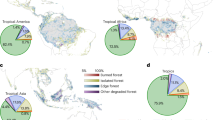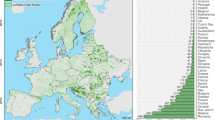Abstract
Human conversion of forest ecosystems to agriculture is a major driver of global change. Conventionally, the impacts of the historical cropland expansion on Earth’s radiation balance have been quantified through two opposing effects: the release of stored carbon to the atmosphere as CO2 (warming) versus the increase in surface albedo (cooling)1. Changing forest cover has a third effect on the global radiation balance by altering emissions of biogenic volatile organic compounds (BVOCs) that control the loadings of multiple warming and cooling climate pollutants: tropospheric ozone (O3), methane (CH4) and aerosols. Although human land cover change has dominated BVOC emission variability over the past century2,3,4, the net effect on global climate has not been quantified. Here, I show that the effects of the global cropland expansion between the 1850s and 2000s on BVOC emissions and atmospheric chemistry have imposed an additional net global radiative impact of −0.11 ± 0.17 W m−2 (cooling). This magnitude is comparable to that of the surface albedo and land carbon release effects. I conclude that atmospheric chemistry must be considered in climate impact assessments of anthropogenic land cover change and in forestry for climate protection strategies.
This is a preview of subscription content, access via your institution
Access options
Subscribe to this journal
Receive 12 print issues and online access
$209.00 per year
only $17.42 per issue
Buy this article
- Purchase on Springer Link
- Instant access to full article PDF
Prices may be subject to local taxes which are calculated during checkout


Similar content being viewed by others
References
Myhre, G. et al. in Climate Change 2013: The Physical Science Basis (ed Stocker, T. F. et al.) Ch. 8, (IPCC, Cambridge Univ. Press, 2013).
Lathiere, J., Hewitt, C. N. & Beerling, D. J. Sensitivity of isoprene emissions from the terrestrial biosphere to 20th century changes in atmospheric CO2 concentration, climate, and land use. Glob. Biogeochem. Cycles 24, GB1004 (2010).
Pacifico, F., Folberth, G. A., Jones, C. D., Harrison, S. P. & Collins, W. J. Sensitivity of biogenic isoprene emissions to past, present, and future environmental conditions and implications for atmospheric chemistry. J. Geophys. Res. 117, D22302 (2012).
Unger, N. Isoprene emission variability through the twentieth century. J. Geophys. Res. 118, 13606–13613 (2013).
Hurtt, G. C. et al. Harmonization of land-use scenarios for the period 1500–2100: 600 years of global gridded annual land-use transitions, wood harvest, and resulting secondary lands. Climatic Change 109, 117–161 (2011).
Brovkin, V. et al. Role of land cover changes for atmospheric CO2 increase and climate change during the last 150 years. Glob. Change Biol. 10, 1253–1266 (2004).
Pongratz, J., Reick, C. H., Raddatz, T. & Claussen, M. Biogeophysical versus biogeochemical climate response to historical anthropogenic land cover change. Geophys. Res. Lett. 37, L08702 (2010).
Findell, K. L., Shevliakova, E., Milly, P. C. D. & Stouffer, R. J. Modeled impact of anthropogenic land cover change on climate. J. Clim. 20, 3621–3634 (2007).
Pitman, A. J. et al. Uncertainties in climate responses to past land cover change: First results from the LUCID intercomparison study. Geophys. Res. Lett. 36, L14814 (2009).
Guenther, A. B. et al. The Model of Emissions of Gases and Aerosols from Nature version 2.1 (MEGAN2.1): An extended and updated framework for modeling biogenic emissions. Geosci. Model Dev. 5, 1471–1492 (2012).
Arneth, A. et al. From biota to chemistry and climate: Towards a comprehensive description of trace gas exchange between the biosphere and atmosphere. Biogeosciences 7, 121–149 (2010).
Shindell, D. T. et al. Improved attribution of climate forcing to emissions. Science 326, 716–718 (2009).
Lamarque, J. F. et al. Historical (1850–2000) gridded anthropogenic and biomass burning emissions of reactive gases and aerosols: Methodology and application. Atmos. Chem. Phys. 10, 7017–7039 (2010).
Unger, N. et al. Attribution of climate forcing to economic sectors. Proc. Natl Acad. Sci. USA 107, 3382–3387 (2010).
O’Donnell, D., Tsigaridis, K. & Feichter, J. Estimating the direct and indirect effects of secondary organic aerosols using ECHAM5-HAM. Atmos. Chem. Phys. 11, 8635–8659 (2011).
Scott, C. E. et al. The direct and indirect radiative effects of biogenic secondary organic aerosol. Atmos. Chem. Phys. 14, 447–470 (2014).
Kiendler-Scharr, A. et al. New particle formation in forests inhibited by isoprene emissions. Nature 461, 381–384 (2009).
Arneth, A. et al. Terrestrial biogeochemical feedbacks in the climate system. Nature Geosci. 3, 525–532 (2010).
Ganzeveld, L. et al. Impact of future land use and land cover changes on atmospheric chemistry–climate interactions. J. Geophys. Res. 115, D23301 (2010).
Ashworth, K., Folberth, G., Hewitt, C. N. & Wild, O. Impacts of near-future cultivation of biofuel feedstocks on atmospheric composition and local air quality. Atmos. Chem. Phys. 12, 919–939 (2012).
Paulot, F. et al. Unexpected epoxide formation in the gas-phase photooxidation of isoprene. Science 325, 730–733 (2009).
Crounse, J. D., Paulot, F., Kjaergaard, H. G. & Wennberg, P. O. Peroxy radical isomerization in the oxidation of isoprene. Phys. Chem. Chem. Phys. 13, 13607–13613 (2011).
Schmidt, G. A. et al. Configuration and assessment of the GISS ModelE2 contributions to the CMIP5 archive. J. Adv. Model. Earth Syst. 6, 141–184 (2014).
Unger, N. et al. Photosynthesis-dependent isoprene emission from leaf to planet in a global carbon–chemistry–climate model. Atmos. Chem. Phys. 13, 10243–10269 (2013).
Shindell, D. T. et al. Interactive ozone and methane chemistry in GISS-E2 historical and future climate simulations. Atmos. Chem. Phys. 13, 2653–2689 (2013).
Griffin, R. J., Cocker, D. R., Seinfeld, J. H. & Dabdub, D. Estimate of global atmospheric organic aerosol from oxidation of biogenic hydrocarbons. Geophys. Res. Lett. 26, 2721–2724 (1999).
Mao, J. et al. Insights into hydroxyl measurements and atmospheric oxidation in a California forest. Atmos. Chem. Phys. 12, 8009–8020 (2012).
Mao, J. et al. Ozone and organic nitrates over the eastern United States: Sensitivity to isoprene chemistry. J. Geophys. Res. 118, 11256–11268 (2013).
Lathiere, J. et al. Impact of climate variability and land use changes on global biogenic volatile organic compound emissions. Atmos. Chem. Phys. 6, 2129–2146 (2006).
Rayner, N. A. et al. Improved analyses of changes and uncertainties in sea surface temperature measured in situ since the mid-nineteenth century: The HadSST2 dataset. J. Clim. 19, 446–469 (2006).
Acknowledgements
Funding for this research was provided by the Leverhulme Trust (UK). This project was supported in part by the facilities and staff of the Yale University Faculty of Arts and Sciences High Performance Computing Center. The author thanks P. A. Raymond and O. J. Schmitz.
Author information
Authors and Affiliations
Contributions
N.U. conceived the study, conducted the global model simulations, analysed the model output and wrote the paper.
Corresponding author
Ethics declarations
Competing interests
The author declares no competing financial interests.
Supplementary information
Rights and permissions
About this article
Cite this article
Unger, N. Human land-use-driven reduction of forest volatiles cools global climate. Nature Clim Change 4, 907–910 (2014). https://doi.org/10.1038/nclimate2347
Received:
Accepted:
Published:
Issue Date:
DOI: https://doi.org/10.1038/nclimate2347
This article is cited by
-
Climate–Vegetation Coverage Interactions in the Hengduan Mountains Area, Southeastern Tibetan Plateau, and Their Downstream Effects
Advances in Atmospheric Sciences (2024)
-
Fire may prevent future Amazon forest recovery after large-scale deforestation
Communications Earth & Environment (2023)
-
Local surface cooling from afforestation amplified by lower aerosol pollution
Nature Geoscience (2023)
-
Cooler forests in clean air
Nature Geoscience (2023)
-
Net-zero approaches must consider Earth system impacts to achieve climate goals
Nature Climate Change (2023)



